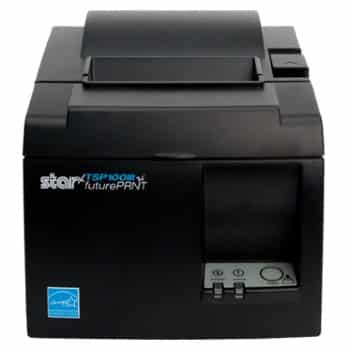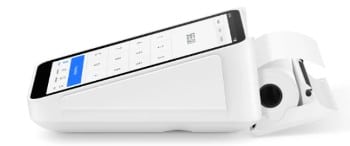Thermal receipt printers are tissue box-sized printers that produce hardcopy receipts for sales transactions. The best ones should be durable, integrate with a wide range of point-of-sale (POS) systems, and print fast enough to keep up with your transaction volume. Pricing for a solid thermal printer averages around $350.
Based on our evaluations, the best thermal printers for small businesses are:
- Star Micronics TSP143IV: Best overall thermal receipt printer for retail and restaurants
- Epson TM-T88VII Omnilink: Best high-speed thermal receipt printer for retail, restaurants, groceries, and pharmacies
- Star Micronics mC-Print3: Best thermal printer for bars and coffee shops
- Square Terminal: Best mobile thermal receipt printer for service businesses, retail, and off-site selling
Best Thermal Receipt Printers Compared
Price* | Print speed | Printer dimensions | Warranty length | |
|---|---|---|---|---|
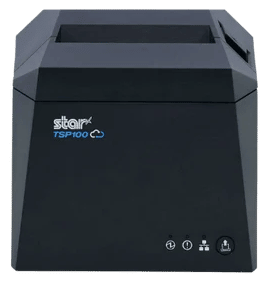 | $264.83 | 250 mm/s | Width: 140 mm Depth: 169 mm Height: 123 mm | 2 years extendable with options to extend or swap |
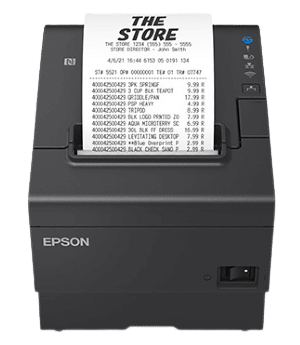 | $359.99 | 500 mm/s | Width: 145 mm Depth: 195 mm Height: 148 mm | 4 years (limited) |
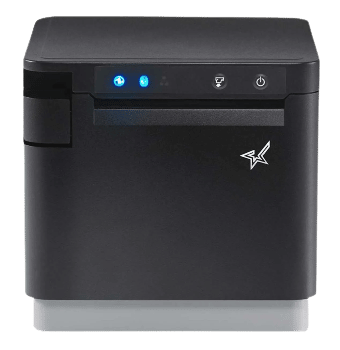 | $498.50 | 250 mm/s | Width: 132 mm Depth: 140 mm Height: 125 mm | 2 years (limited) with options to extend or swap |
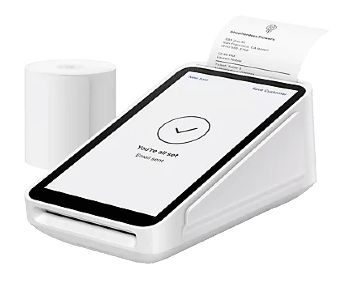 | $299 upfront (or $27 per month for $12 months) | 100 mm/s | Width: 86.4 mm Depth: 142.2 mm Height: 63.5 mm | 1 year |
* Prices vary based on connection type and vendor ** See individual provider sections for full list of compatible POS systems | ||||
Small businesses commonly use thermal receipt printers that print using heat on thermosensitive paper. These printers use either direct or thermal transfer printing.
- With direct thermal printing, the printer applies heat directly to a media base such as receipt paper or a label. This process does not require ink or ribbons, saving on long-term expenses. It produces a clear print, but the information can fade away or be erased if exposed to heat or light.
- With thermal transfer printing, the printer applies heat to an ink ribbon, which then melts onto the media base to form text or images. This type of device does require a constant supply of ink, but produces long-lasting receipts or labels that are more resistant to heat and light.
Both types of thermal receipt printer can connect to a cash register or POS system. You can purchase them directly from retailers or via your POS system supplier.
Star Micronics TSP143IV: Best Overall Thermal Receipt Printer
Check out Star Micronics TSP143IV
Epson TM-T88VII: Best High-speed Thermal Receipt Printer
Star Micronics mC-Print3: Best Receipt Printer for Bars
Check out Star Micronics mC-Print3
Square Terminal: Best Mobile Thermal Receipt Printer
How to Choose a Thermal Receipt Printer
When choosing the best printer for your business, it might be tempting to just pick the device with the fastest printing speed or the most flexible connectivity. If these are your only criteria, though, you might end up with a device that’s overbuilt for your needs. Most printers cost several hundred dollars, and you could easily go above your budget if you’re not careful. You need to take other factors into account as well when choosing a thermal receipt printer.
Printing Speed
While higher printing speeds are good, you don’t want to end up with something excessively fast, as it would also likely be excessively expensive. Use your POS system to get an idea of the number of transactions you process per day and work with your staff to assess how long each transaction takes. This information can help you choose a printer with the appropriate speed. In general, high-volume businesses like busy restaurants will want faster printers, while smaller shops could get by with slower ones.
Connectivity
Different thermal printers will have different options for connectivity; as an example, the Square Terminal can only connect via Wi-Fi, while Star Micronics printers offer a whole slew of options including USB, Bluetooth, and printing via local or cloud-based server. Thus, the type of POS system you are using, as well as your actual or desired level of sales mobility, need to factor into your choice of printer.
Media Type & Size
Besides knowing what you need to print—receipts, labels, cards, price tags—you’ll also need to be certain of the print size you need. Thermal printers can usually only print within a fairly narrow range of widths, so you’ll need to be clear about whether the printer you’re considering can deliver what you need. For example, the Square Terminal uses its own smaller printer paper which you’ll need to buy from Square.
Physical Dimensions & Durability
It’s easy enough to figure out how much physical space in your store you can allocate for a printer, but you also need to consider durability. A receipt printer placed on the counter of a quick-service restaurant will need some resistance against liquid splashes and food spills, and printers that are crammed into small spaces, surrounded by other equipment, or churning out receipts all day will need to be able to tolerate heat buildup.
Customer Support
Finally, consider customer support availability when choosing a thermal receipt printer. This is important if you need to process transactions quickly for lots of customers, or if you only have one printer in your shop; in these cases, a device breakdown or malfunction without speedy customer support to get it fixed could tank your sales for the day, not to mention lead to impatient or irritated customers.
Looking for more hardware? Check out our rankings of the top barcode label printers, leading self-service kiosks, and best kitchen display systems for more options.
Methodology—How We Evaluated Thermal Receipt Printers
We compared a dozen popular and emerging thermal receipt printers based on qualities important to small shop and restaurant owners. We weighed the price, general features, and ease of use for each printer. We also considered our retail and restaurant experts’ opinions of each hardware option and any special use cases (like full mobility) that support different business types.
Using the above criteria, the Star Micronics TSP143IV emerged as the best thermal receipt printer. This printer received the highest overall score according to our ranking system (4.70 out of 5). Based on our personal experience working in and with small businesses that use thermal receipt printers every day, the Star Micronics TSP143IV is also the top printer we personally recommend.
Click through the boxes below for our full evaluation criteria:
20% of Overall Score
Many small businesses will need to purchase several thermal receipt printers, so we looked for printers priced below $500 each. We awarded the highest marks to printers priced below $300.
30% of Overall Score
We considered each printer’s print speed, connection types, and available POS integrations. We looked specifically for printers that can act as a power hub for mobile POS terminals. We also looked for features like auto cutters with a long life span and de-curl functions.
30% of Overall Score
20% of Overall Score
Finally, we relied on our experts’ experiences with these printers and their evaluation of any standout features. We considered each printer’s popularity among small retail and restaurant businesses. We also considered whether each printer offered good overall value for its price.
Thermal Receipt Printers Frequently Asked Questions (FAQ)
A thermal printer is just a printer that uses precise heat application, rather than ink ribbons or cartridges, to create text or images on paper. Thermal printers work by either applying heat directly to a media base such as receipt paper (direct thermal printing) or heating ink or colored resin or wax and then depositing that onto the media base (thermal transfer printing).
Yes. Direct thermal printers are popular for printing receipts because they do not require ink cartridges for printing, eliminating a potentially large and continuous business expense. This lack of a need for ink makes thermal printers cost-effective for high-volume printing tasks like receipts for busy shops and restaurants.
Direct thermal receipt printers and only print text or images in grayscale on heat-sensitive paper. Because of this, their color options are limited. Thermal transfer printers can print in color; various types can print different numbers of colors. These printers tend to be used for special tasks like printing on fabric or plastic films, rather than printing basic receipts.
Bottom Line
When it comes to thermal receipt printers, it’s hard to find a bad one. But if you’re looking for the best thermal receipt printer available, you should try the Star Micronics TSP143IV. This printer combines an accessible price and respectable print speed with a durable print head and long-lived auto cutter.
The real ace up this printer’s sleeves are the CloudPRNT and PromoPRNT settings that allow you to print receipts and coupons directly from cloud-based applications like online ordering apps. To see if the TSP143IV is the right printer for your shop or restaurant, explore the printer for yourself.

